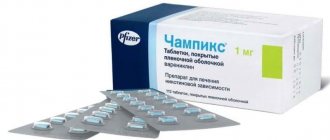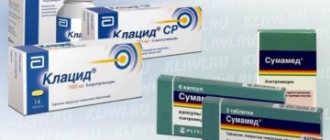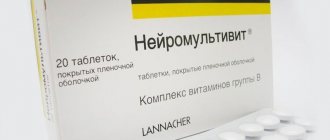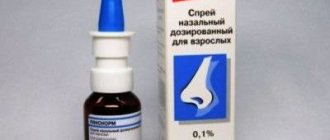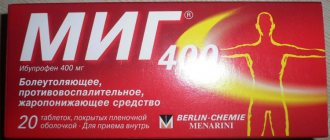Spironolactone is a complex diuretic (diuretic) drug with potassium-sparing properties that helps cope with various diseases of the body associated with severe tissue swelling.
Due to its good diuretic effect, it exhibits a pronounced hypotensive (reduces high blood pressure) effect.
The main active ingredient is Spironolactone, while the auxiliary components are lactose, potato starch, calcium stearate, monohydrate, povidone, etc.
After internal administration, it is quickly absorbed from the gastrointestinal tract, with the main diuretic effect appearing within 2-3 hours.
It is well tolerated by patients of all ages without the development of significant side effects.
Main indications for use of Spironolactone:
- essential hypertension;
- pronounced edematous syndrome;
- complex treatment of chronic heart failure;
- hypokalemia (insufficient amount of potassium in the body);
- nephrotic syndrome;
- hypomagnesemia (lack of magnesium in the body);
- ascites;
- hyperaldosteronism.
Attention: before using this drug, it is recommended to consult a physician!
Available in the form of soluble tablets for oral (internal) administration.
Instructions for use of Spironolactone
Spironolactone requires careful adherence to the instructions for use, taking into account the dosage and characteristics of the patient’s body. A powerful diuretic has a large number of nuances of use. Otherwise, side effects may occur, including changes in hormonal levels and toxic effects on the liver. Proper use minimizes the negative effects of the drug.
Related articles Which tablets for high blood pressure are the most effective Tablets for swelling The most effective drugs for hypertension
Composition and release form
The drug Spironolactone is available in the form of tablets containing the active substance of the same name in the dosage indicated on the package. Additionally, the drug includes auxiliary components: calcium stearate, lactose, monohydrate, potato starch. Different types of release depend on the dose of the main active ingredient. Spironolactone tablets exist in the following form:
| Release form | Main substance content |
| Spirolactone 25, 20 tablets | 25 mg |
| 25 mg, 30 tablets | 25 mg |
| Spironolactone 100 mg, 20 tablets | 100 mg |
| 100 mg, 30 tablets | 100 mg |
Pharmacodynamics and pharmacokinetics
The action of Spirolactone is based on the property of the main active component to have a diuretic effect, reduce swelling of various origins, and menstrual pain in polycystic ovary syndrome. The main mechanism of action of the drug is competitive antagonism with aldosterone (a hormone that promotes urine excretion) in the distal tubules of the nephron.
The drug has a magnesium- and potassium-sparing effect, therefore it is indicated for heart failure and disorders of microelement metabolism. The medicine reduces the excretion of urea and reduces the acidity of urine. Absorption occurs in the gastrointestinal tract, forming the metabolite canrenone. The latter is subsequently excreted by the kidneys and liver using bile. The half-life ranges from 13 to 24 hours.
Indications for use of Spironolactone
In contrast to many other diuretics, the use of Spironolactone is not prohibited; it is even indicated for problems of the cardiovascular system due to its basic property: preserving the potassium and magnesium necessary for the body. Doctors recommend the drug for the following conditions:
- Primary hyperaldosteronism, including those caused by adrenal adenoma (Conn's syndrome). The instructions recommend long-term therapy if a surgical solution to the problem is not possible. The drug reduces disease-associated hypertension.
- Liver cirrhosis, associated edema, hypokalemia.
- Nephrotic syndrome associated with renal dysfunction hypertension.
- Pregnancy-related swelling (only in the second and third trimester), ovarian dysfunction.
- Hypokalemia, prevention of the condition while taking other drugs for edema.
- Severe premenstrual syndrome, polycystic ovary syndrome.
Dosage regimen
They are set individually depending on the severity of disturbances in water-electrolyte metabolism and hormonal status. For edematous syndrome - 100-200 mg/day. (less often - 300 mg/day) in 2-3 doses (usually in combination with a loop and/or thiazide diuretic) daily for 14-21 days. Dose adjustments should be made taking into account plasma potassium concentrations. If necessary, courses are repeated every 10-14 days. With severe hyperaldosteronism and reduced potassium content in plasma - 300 mg/day. in 2-3 doses.
Side effects
Spironolactone is a heavy drug with numerous undesirable effects. Some of them: nausea, vomiting, constipation, increased manifestations of chronic gastritis, are not considered clear indications for discontinuing the medication. The final decision should rest with the attending physician, who is aware of all the details of the patient's condition. The following side effects of Spironolactone are common:
- Effect on the gastrointestinal tract: diarrhea or constipation, stomach pain, transition of gastritis to an ulcer.
- On the central nervous system: headache, dizziness, lethargy, ataxia (loss of coordination). The instructions recommend caution when driving while taking Spironolactone.
- Metabolic disorders: hypercreatininemia, hyperuricemia, acidosis, alkalosis, hyperkalemia, hyponatremia, agranulocytosis.
- Hormonal imbalance provokes, with long-term use, deepening of the voice, dysmenorrhea or amenorrhea, hirsutism, breast carcinoma in women, gynecomastia, and impotence in men.
- Rashes are possible due to individual intolerance to the components of the drug.
Contraindications
- Addison's disease;
- Hypercalcemia;
- Hyperkalemia;
- Hyponatremia;
- Anuria;
- Chronic renal failure;
- Liver failure;
- Diabetic nephropathy;
- Diabetes;
- Metabolic acidosis;
- Enlargement of the mammary glands;
- Menstrual irregularities;
- I trimester of pregnancy;
- Lactation period;
- Hypersensitivity to the drug.
Special monitoring of the condition during treatment is necessary for patients with impaired liver function.
Overdose
Spironolactone is a drug that must be taken in a specified amount. Exceeding the norm leads to serious deviations in vital activity and biological processes. An overdose is fraught with increased urea concentrations, dehydration, headache, nausea, and vomiting. Hyponatremia manifests itself in the form of thirst and dry mouth. Hyperkalemia in extreme cases can lead to cardiac arrest. People with hypertension experience a sharp decrease in blood pressure, seizures, and arrhythmia.
Drug interactions
When used simultaneously with antihypertensive drugs, the hypotensive effect of spironolactone is potentiated. When used simultaneously with ACE inhibitors, hyperkalemia may develop (especially in patients with impaired renal function), because ACE inhibitors reduce aldosterone levels, which leads to potassium retention in the body while limiting potassium excretion. When used simultaneously with potassium supplements, other potassium-sparing diuretics, table salt substitutes and dietary supplements containing potassium, hyperkalemia may develop. When used simultaneously with salicylates, the diuretic effect of spironolactone is reduced due to blockade of canrenone excretion by the kidneys. Indomethacin and mefenamic acid inhibit renal excretion of canrenone. With simultaneous use, the hypoprothrombinemic effect of oral anticoagulants is reduced. When used simultaneously with digitoxin, it is possible to either enhance or reduce the effects of digitoxin. When used concomitantly, spironolactone inhibits the renal excretion of digoxin and likely reduces its volume of distribution. This may cause an increase in plasma digoxin concentrations. When used simultaneously with candesartan, losartan, eprosartan, there is a risk of developing hyperkalemia. When used simultaneously with cholestyramine, cases of hypochloremic alkalosis have been described. When used simultaneously with lithium carbonate, it is possible to increase the concentration of lithium in the blood plasma. When used simultaneously with norepinephrine, it is possible to reduce the sensitivity of blood vessels to norepinephrine. With simultaneous use, the effect of triptorelin, buserelin, and gonadorelin is enhanced.
Spironolactone analogues
The drug has analogues, the mechanism of action of which largely coincides with the drug Spirolactone. Some of them differ only in price, being generics of the main one. Others have specific compositions and can be prescribed in cases where the original is contraindicated. When choosing an analogue intended for replacement, consultation with a specialist is necessary. Main drugs:
- Verospilactone is a potassium-sparing diuretic, produced in a dosage of 25 mg, not suitable for independent use, used exclusively as part of combination therapy.
- Verospiron is a Hungarian analogue of the original drug and has an excellent, milder effect. Patient reviews noted a small number of side effects and easy tolerability.
- Espiro - intended specifically for people suffering from severe heart failure, prevents deaths due to the disease, and is a more powerful analogue.
special instructions
It is recommended to do blood tests while taking the drug.
Since the drug contains lactose monohydrate, it is absolutely contraindicated in patients with congenital lactose intolerance.
During drug therapy, it is necessary to regularly donate blood and urine for analysis, this will help monitor the level of urea and electrolytes. The tests will also show the dynamics of therapy and the general condition of the patient.
Treatment should be under the supervision of a physician if the patient has diseases such as liver cirrhosis and hyperkalemia.
During the use of Spironoloctone, deterioration of health, dizziness and drowsiness may occur. Therefore, it is recommended to refrain from driving a car, as well as from all activities that require high concentration.
As part of complex therapy, the dosage must be calculated extremely accurately. Failure to comply with the recommended dose and treatment regimen can result not only in side effects, but also in various complications.
Price
The drug is not expensive. It is available, but requires a doctor's prescription to purchase. Pricing policy depends on the specific pharmacy. The cost of the medicine in the Moscow region is as follows:
| Pharmacy | Price, rubles |
| "Hey, hello" | 41 |
| "A-mega" | 43 |
| "Pharmacy No. 294 of General Kuznetsov" | 46 |
| "ASNA - Samarkand Boulevard" | 52 |
Release forms and composition
The tablet form of the drug has a flat cylindrical shape and is white with a yellowish tint. There is a risk on the front side. Units of the drug have a specific odor. 1 tablet contains 25 mg of the active compound - spironolactone. The manufacturer Sandoz uses as additional ingredients:
- milk sugar;
- dehydrogenated colloidal silica;
- magnesium stearate;
- povidone K25;
- corn starch.
The tablet form of the drug has a flat cylindrical shape and is white with a yellowish tint.
The drug is packaged in 10 tablets in contour cell blisters or 20-100 pcs. in polyethylene terephthalate jars.
The second form of release is capsules with a gelatin hard shell containing 50 or 100 mg of the active ingredient (spironolactone). Inside they contain a mixture of granules and white powder. Auxiliary elements necessary for rapid absorption:
- sodium lauryl sulfate;
- magnesium stearate;
- lactose sugar;
- corn starch.
The outer shell consists of gelatin, titanium dioxide, sodium lauryl phosphate, methyl parahydroxybenzoate, glycerin, distilled water, propyl parahydroxybenzoate.
The second form of release is capsules with a gelatin hard shell containing 50 or 100 mg of the active ingredient (spironolactone).
Reviews
Veronica, 26 years old
I took Spironolactone on the recommendation of a gynecologist, because first I had polycystic ovary syndrome, then a difficult pregnancy with edema. In both cases, on the third or fourth day it began to pass. The diuretic effect was pronounced, but not painful; I did not have to live next to a toilet. I didn’t experience any side effects, everything was fine.
Tatyana, 62 years old
I suffer from heart failure, and I take the drug periodically in courses. It does its job, but there are many unpleasant side effects, the head always hurts, the pressure begins to drop, because of this it makes you sleepy, it is difficult to concentrate on any everyday activities. Negative manifestations intensify over time.
Leonid, 49 years old
I was prescribed this drug before surgery for an adrenal tumor. The course was short, but I remember it as difficult, I constantly felt sick, my stomach hurt, and I vomited several times. The diuretic effect is also pronounced and unpleasant, a constant feeling of the need to go to the toilet. I have noticed increased thirst while taking this medication.
Pharmacokinetics
Suction
After oral administration, it is quickly and completely absorbed from the gastrointestinal tract; bioavailability is 100%. After daily administration of 100 mg of spironolactone for 15 days, Cmax is 80 ng/ml, the time to reach Cmax after the next morning dose is 2-6 hours.
Distribution
Binds to plasma proteins by 98%.
Spironolactone penetrates poorly into organs and tissues, while spironolactone itself and its metabolites penetrate the placental barrier, and canrenone passes into breast milk. Vd - 0.05 l/kg.
Metabolism
During the biotransformation process in the liver, active sulfur-containing metabolites 7-alpha-thiomethylspironolactone and canrenone are formed. Canrenone reaches its Cmax after 2-4 hours, its binding to plasma proteins is 90%.
Removal
T1/2 - 13-24 hours. Excreted mainly in urine (50% in the form of metabolites, 10% unchanged) and partially in feces. Canrenone excretion (mainly in the urine) is biphasic, T1/2 in the first phase is 2-3 hours, in the second - 12-96 hours.
Pharmacokinetics in special clinical situations
In liver cirrhosis and heart failure, the duration of T1/2 increases without signs of cumulation, the likelihood of which is higher in chronic renal failure and hyperkalemia.


